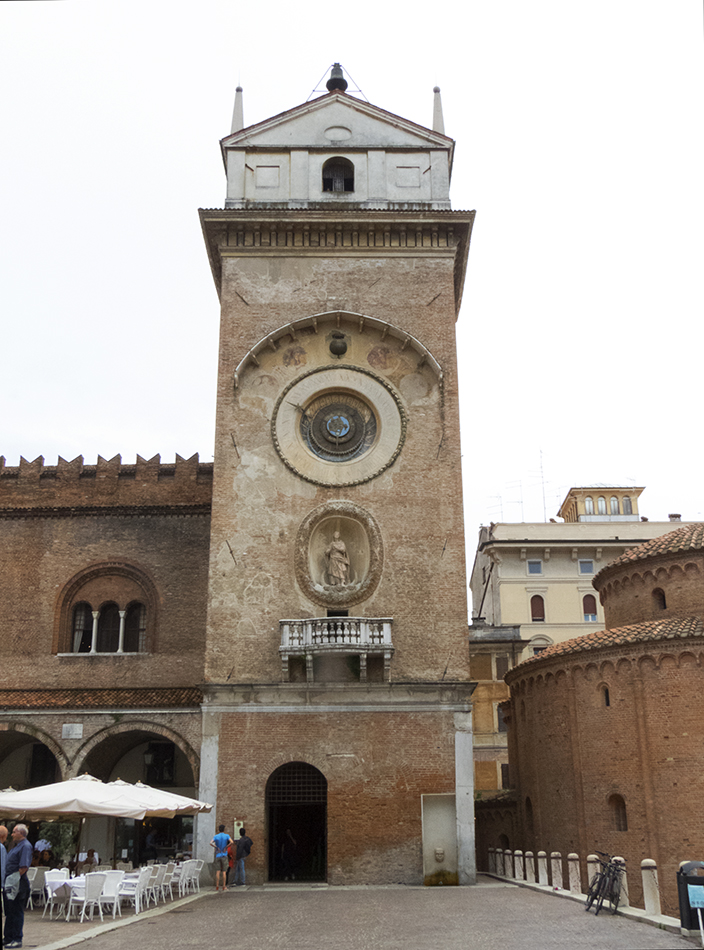
Although time and its measurement is a fundamental component of human life, a special type of clock which takes matters to the next level is the so-called
astronomical clock and whose purpose is not to measure time per se but to convey astronomical information and, in particular, the relative position of the
Sun and Moon as well as the zodiacal constellations and, in some cases, the position of the planets all as a function of time.
The oldest such effort to effectively emulate the overhead celestial sphere (ie a mini-planetarium) is the
Antikythera Mechanism which was discovered in 1901 totally by
accident by sponge divers off the coast of the Greek island of Antikythera. It has been dated to approximately 80 BC and it is believed to be the work of
Poseidonius of Rhodes. The Antikythera Mechanism is currently on display
at the National Archaeological Museum in Athens, Greece.
Note: Lying approximately half-way between Milan and Padova, the town of Mantova has the distinction of having the second oldest
astronomical clock in Italy and which is preceeded only by the stunning clock at
Padova.
Sitting in the town's primary square, Piazza delle Erbe, the clock tower forms part of an architectural complex which includes the Palazzo della Ragione to
its immediate left and the stunning Rotonda di San Lorenzo to its immediate right with the Florentine architect Luca Fancelli being the primary architect of
the square during the 15th century.
The tower hosting the astronomical clock was constructed in 1473 AD as the final piece accompanying the Palazzo della Ragione. It is quite unique in many ways by
virtue of the fact it is accompanied by both a canopy above and a marble balcony below the clock; it was surrounded by twelve frescoes with only four frescoes
having survived both time and various earthquakes; Latona (the supposed mother of Apollo and Diana who invariably represent the Sun and Moon) is depicted in the
innermost circle and where the phases of the Moon are illustrated courtesy of a Moon above Latona's head; dials from Latona's outstretched left and right hands
indicate the sign of the zodiac the Moon is passing through as well as the day of the lunar cycle; a dial with a figurine for the Sun which indicates the current
zodiacal constellation the Sun is passing through; a blue semi-ring which indicates the ecliptic; two sets of roman numerals ranging from I to XII differentiating
the daytime and nightime hours; and, finally, the outermost ring numbered from I to XXIV representing the hour of day.
The clock tower's internals are open to the public and include access to the mechanism (at the mid-section of the tower) and the clock museum on the upper section.
Note: For a view of the astronomical clock using greater focal length, please click
here and
here.
Note: For additional results involving astronomical clocks from around the world, please click
here.
|
Body: Sun Mass: 332,900 x Earth Mass Eq Diameter: 109.1 x Earth Distance: 149 million km RA / Dec: 23h 41m 41s / +89° 19' 51" Diameter: 32.16' Magnitude: -26.8 |
 |
Date: June 10, 2023 Location: Piazza delle Erbe, Mantova, Italy Equipment: Canon PowerShot SX60 HS @ 7.08 mm / f8.0 Exposure: 1 x 1/500 sec ISO 400 RAW Image Format 4768x3516 Image Size Continuous Servo Mode Manual Mode Software: Photoshop CS6 Processing: Brightness/Contrast Resampling JPG Compression |